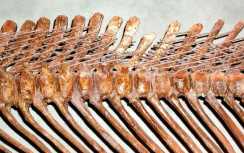
 |
| You might also like: | Ornithomimus | Oviraptor | Corythosaurus | Pachycephalosaurus | Parasaurolophus | Today's featured page: T. rex Fact Sheet |
| ZoomDinosaurs.com ALL ABOUT DINOSAURS! |
| What is a Dinosaur? | Dino Info Pages | Dinosaur Coloring Print-outs | Name That Dino | Biggest, Smallest, Oldest,... | Evolution of Dinosaurs | Dinos and Birds | Dino Myths |
| EDMONTOSAURUS "Edmonton [Rock Formation] lizard" |
Edmontosaurus had leathery skin (as determined from two mummified Edmontosaurus fossils found in Wyoming). It may have had loose skin around its nose area - some paleontologists think that it may have been able to blow up this skin like a balloon, perhaps for mating rituals or intra-species rivalry. It had a series of bumps (tubercles) running along its neck, back, and tail.
 |
 These great photos were taken by Jim Puckett in the Dinosaur Hall of "Prehistoric Journey" at the Denver Museum of Nature and Science. Jim reports, "It was originally discovered and unearthed by Barnum Brown. It is 80% real bone and 20% reconstructed (the head is a cast, but they do have the real skull on nearby display - it js too heavy to mount with that little
wire holding its head up). On its tail [close-up pictured at right] is what is thought to be a
T-Rex bite mark with a small missing piece of vertebra while it was
still alive because, after careful examination, it showed the bone began
to regrow. There are also some bite marks around it in a concave fashion
and Ken Carpenter slid a T-Rex tooth thru it and it fit perfectly. So,
ergo, it was most likely a T-Rex attack on live prey, which would show
that T-Rex was indeed a predator along with being a scavanger like most
predators are anyway in the animal kingdom. Less effort and energy is
needed to scavenge rather than chase down prey." These great photos were taken by Jim Puckett in the Dinosaur Hall of "Prehistoric Journey" at the Denver Museum of Nature and Science. Jim reports, "It was originally discovered and unearthed by Barnum Brown. It is 80% real bone and 20% reconstructed (the head is a cast, but they do have the real skull on nearby display - it js too heavy to mount with that little
wire holding its head up). On its tail [close-up pictured at right] is what is thought to be a
T-Rex bite mark with a small missing piece of vertebra while it was
still alive because, after careful examination, it showed the bone began
to regrow. There are also some bite marks around it in a concave fashion
and Ken Carpenter slid a T-Rex tooth thru it and it fit perfectly. So,
ergo, it was most likely a T-Rex attack on live prey, which would show
that T-Rex was indeed a predator along with being a scavanger like most
predators are anyway in the animal kingdom. Less effort and energy is
needed to scavenge rather than chase down prey." |
INTELLIGENCE
Edmontosaurus was an ornithopod, whose intelligence (as measured by its relative brain to body weight, or EQ) was midway among the dinosaurs.
Edmontosaurus herds may have migrated thousands of miles seasonally, traveling from the North Slope of Alaska (which would have been dark for months at a time during winter, making plants scarce) to Alberta, Canada (which was rich in green plants during winter). Large numbers of Edmontosaurus fossils have been found at both ends of this proposed migratory route.
DIET
Edmontosaurus was an herbivore, a plant eater. Fossilized conifer needles have been found in Edmontosaurus' stomach. It ate conifer needles, twigs, seeds, and other plant material with its tough beak. It had no teeth in its beak, but had hundreds of cheek teeth used for grinding up tough plant material.
ENEMIES
The almost defenseless Edmontosaurus was preyed upon by Tyrannosaurus rex. T. rex may have even followed Edmontosaurus' migration routes in search of a series of good meals. Other predators of Edmontosaurus may have included Albertosaurus,
LOCOMOTION
A Hadrosaur footprint. |
 (and Other Prehistoric Creatures) |
Enchanted Learning®
Over 35,000 Web Pages
Sample Pages for Prospective Subscribers, or click below
|
Overview of Site What's New Enchanted Learning Home Monthly Activity Calendar Books to Print Site Index K-3 Crafts K-3 Themes Little Explorers Picture dictionary PreK/K Activities Rebus Rhymes Stories Writing Cloze Activities Essay Topics Newspaper Writing Activities Parts of Speech Fiction The Test of Time
|
Biology Animal Printouts Biology Label Printouts Biomes Birds Butterflies Dinosaurs Food Chain Human Anatomy Mammals Plants Rainforests Sharks Whales Physical Sciences: K-12 Astronomy The Earth Geology Hurricanes Landforms Oceans Tsunami Volcano |
Languages Dutch French German Italian Japanese (Romaji) Portuguese Spanish Swedish Geography/History Explorers Flags Geography Inventors US History Other Topics Art and Artists Calendars College Finder Crafts Graphic Organizers Label Me! Printouts Math Music Word Wheels |
Click to read our Privacy Policy
| Search the Enchanted Learning website for: |